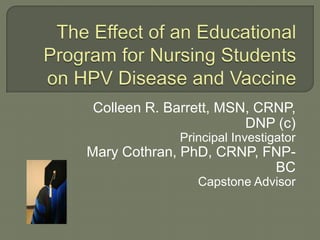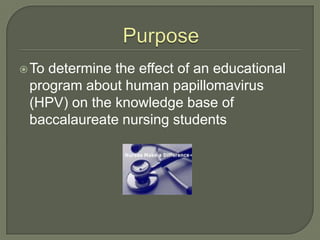Capstone Powerpoint Presentation
- 1. The Effect of an Educational Program for Nursing Students on HPV Disease and VaccineColleen R. Barrett, MSN, CRNP, DNP (c) Principal InvestigatorMary Cothran, PhD, CRNP, FNP-BCCapstone Advisor
- 2. PurposeTo determine the effect of an educational program about human papillomavirus (HPV) on the knowledge base of baccalaureate nursing students
- 3. Implications for StudyLimited research has shown a knowledge deficit about HPV among nursing students Educational programs on HPV for this group may translate to improved personal and public health
- 4. Background and SignificanceHPVMost common STI in the US (1,2)Infects 6.2 million US residents annually (1)
- 5. Background and SignificanceHPVOver 100 strains; at least 40 known to be oncogenic (3).Types 6 and 11-low risk. Cause majority of genital warts (condyloma) (4).Types 16 and 18 most oncogenic. Together cause over 80% of cervical cancers (4).
- 6. Cervical CancerIn the US in 2005 (7)11,999 newly diagnosed3,924 died of the disease
- 7. Cervical CancerWorldwide (9)HPV causes over 500,000 cases of genital cancers annually 370,000 of those are known cervical cancers 270,000 of those will lead to death
- 8. HPV preventionPrimary prevention of the human papillomavirus is now possible.
- 9. HPV PREVENTIONVaccinationJune 2006: prophylactic, quadrivalent HPV 6/11/16/18 VLP vaccine (Gardasil) was licensed for useIndicated for males and females ages 9-26Has been shown to prevent up to 70% of cervical cancers caused by HPV 16/18 (14).
- 10. Knowledge DeficitNumerous surveys on college campuses in US and Canada:Low level of HPV knowledge among college students and nursing students
- 11. Knowledge DeficitIngledue, et al.College studentsDenny-Smith, et al.nursing studentsBoth studies revealed poor knowledge, low perception and high risk sexual behaviors
- 12. Knowledge DeficitData support the need to educate adolescents and women about HPVStudies reveal women desire more information about HPV (24)
- 13. HPV EducationFew studies on effect of HPV-focused educational programsLambert (25) evaluated the effectiveness of a brief HPV focused educational programPhysician Assistant and Psychology studentsData revealed statistically significant improvement in HPV knowledge scores after the program
- 14. STD and Pregnancy Prevention ProgramsHave been shown in literature to be successfulAnderko and Uscian (22)Studied decreasing risky sexual behaviorKirbyResearch review revealed success with educational programs on HIV prevention
- 16. SampleConvenience sample of full time senior level undergraduate nursing students (n=18)Demographic data analyzed using frequencies and averagesMean age of students was 22.53 years (SD 1.13) ŌĆōafter removal of 3 outliers (ages 33, 37, 42)
- 17. SampleParticipation was voluntaryCompletion of study materials considered implied consentNo incentives offered for participationStudy approved by IRB at RMU and Human SubjectŌĆÖs Review Board at host university
- 18. InstrumentThe Awareness of HPV and Cervical Cancer Questionnaire (23)40 item multiple choice questionnaireDeveloped to assess knowledge, perceptions, and preventive behaviors regarding HPV and cervical cancer
- 19. InstrumentPermission to use granted by author, Ingledue (23)Stability reliability established by test-retest proceduresTest-retest coefficients of 0.90 reported for knowledge; 0.95 for perceptions and 0.90 for behaviors
- 20. InstrumentNo data reported for internal consistencyContent validity established via consensual validity using a panel of health expertsInstrument was approved by a Human SubjectŌĆÖs committee
- 21. InstrumentFor present study, only the knowledge items of the instrument were usedMultiple choice questionsOne correct answerCorrect answers assigned one pointScore range of 0 to 15
- 22. Data CollectionDemographic questionnaire with cover letter describing studyQuestionnaires numbered by authorPre-test/post test-numbered by participantsAll placed in privacy envelopes upon completion.
- 23. Educational InterventionObjectivesIncrease general knowledge of HPV disease and its sequelaeIdentify-Risk factors for HPV and cervical cancerSymptoms of HPV infectionMeans to prevent HPV and cervical cancerMeans of detecting HPV and cervical cancer
- 24. Educational InterventionContent:HPV typesHPV incidence, prevalence and pathogenesisHPV risk factors and sequelaeVarious stages of cervical dysplasia and cervical cancerCervical cancer statisticsKnowledge deficitQuadrivalent HPV vaccine
- 25. Educational InterventionConcluded with open question and answer period
- 26. Data AnalysisData entered into Access ExcelPaired t-testAnalysis performed using SPSS 17.0
- 27. ResultsMean of pre-test: 10.83 (SD 1.043)Mean of post-test: 13.78 (SD 1.166)t=7.517(7), p=.000
- 28. DiscussionMean pre-test score: 72%Mean post-test score: 91%
- 29. DiscussionUndergraduate nursing studentsWill be able to disseminate accurate information about HPV disease and vaccine to patientsMay be of the age group recommended to receive the vaccine themselvesImproved knowledge in this group may contribute to public health both directly and indirectly
- 30. DiscussionStudy limitationsSmall sample sizeHomogeneity of sampleVaccine knowledge not assessed38.9% of students reported some previous education on HPV diseaseEntire tool not utilized
- 31. Future ResearchShould include larger sample sizeNursing students in various pre-licensure programsMore heterogeneous sampleAssess knowledge retention over timeVaccine knowledge (instrument development)Vaccination status pre- and post-programInclude practicing nurses and their practice habits as they pertain to patient education
- 32. Implications for StudyHPV incidence and subsequent cervical disease burden may be reduced through education of nursesNurses can have positive effect public health as they disseminate accurate information
- 33. References 1. Fontenot HB, Collins Fantasia H, Allen JD. HPV in adolescents: Making the wake up call. Adv Nurse Pract. 2007;15(10): 73-76. 2. Denny-Smith T, Bairan A, Page M. C. A survey of female nursing studentsŌĆÖ knowledge, health beliefs, perceptions of risk, and risk behaviors regarding human papillomavirus and cervical cancer. J AmAcad Nurse Pract. 2006;18:62-69. 3. OŌĆÖBrien J. 11th annual conference on vaccine research. Expert RevVaccines. 2008;7(6):721-723. 4. Bosch, FX, & de Sanjose, S. (2003). Chapter 1: Human papillomavirus and cervical cancer burden and assessment of causality. J Natl CancerInst Monogr. 2003;31;3-13
- 34. References5. Walboomers JMM, Jacobs M, Manos N, Bosch F, Kummer A, Shah K. Human papillomavirus is a necessary cause of invasive cervical cancer worldwide. J Pathol. 1999;189:12-19. 6. Oaknin A, Pilar-Barretina M. Human papillomavirus vaccine and cervical cancer prevention. Clin and Transl Oncology. 2008;10:804-811. 7. Cervical cancer statistics. Centers for Disease Control Website. http://www.cdc.gov/cancer/cervical/statistics/index.htm. Updated July 20, 2009. Accessed September 3, 2009. 8. Buttin B, Herzog T, Mutch D. Abnormal cytology and human papillomavirus. In: Curtis M, Overholt S, Hopkins M. GlassŌĆÖ Office Gynecology. 6th ed. Philadelphia, PA: Lippincott, Williams and Wilkins; 2006:80-106
- 35. References 9. Block S, Nolan T, Sattler C, Barr E, Giacoletti KED, Marchant CD, et al. Comparison of the immunogenicity and reactogenicity of a prophylactic quadrivalent human papillomavirus (types 6, 11, 16, 18) l1 virus-like particle vaccine in male and female adolescents and young adult women. Pediatrics. 2006;118(5);2135-2145. 10. Future I Study Investigators. Quadrivalent vaccine against human papillomavirus to prevent anogenital diseases. N England J Med. 2007;356(19):1928-1943. 11. Parkin D, Pisani P, Ferlay J. Estimates of the worldwide incidence of mortality from 25 cancers in 1990. Int J Cancer. 1999;80:827-841.
- 36. References15. Cancer Prevention & Early Detection Facts & Figures. American Cancer Society Website http://www.cancer.org/downloads/STT/CPED_2008.pdf. Reported as of November 30, 2007. Accessed September 3, 2009. 16. Nanda K, McCrory DC, Myers ER, et al. Accuracy of the Papanicolaou test in screening for and follow-up of cervical cytologic abnormalities: a systematic review. Ann Intern Med. 2000;132:810-819. 17. Adams M, Jasani B, Fiander, A. Human papillomavirus (HPV) prophylactic vaccination: challenges for public health and implications for screening. Vaccine. 2007;25:3007-3013.
- 37. References18. Future II study group. Quadrivalent vaccine against human papillomavirus to prevent high-grade cervical lesions. N Engl J Med. 2007;356(19):1915-1927. 19. Zimet GD, Liddon N, Rosenthal SL, Lazcano-Ponce E, Allen B. Psychosocial aspects of vaccine acceptability. Vaccine. 2006;24S3, S3/201-S3/209. 20. Ramirez J, Ramos D, Clayton L, Kanowitz S, Moscicki. Genital human papillomavirus infections: Knowledge, perception of risk, and actual risk in a nonclinic population of young women. J Womens Health. 1997;6:113-121.
- 38. References21. Pitts M, Clarke T. Human papillomavirus infections and risks of cervical cancer: what do women know? Health Educ Res. 2002;17(6):706-714. 22. Baer H, Allen S, Braun L. Knowledge of human papillomavirus infection among young adult men and women: implications for health education research. J Community Health. 2000;25:67-78. 23. Yacobi E, Tennant C, Ferrante J, Naazneen P, Roetzheim R. University students' knowledge and awareness of HPV. Prev Med. 1999; 28:535-541.
- 39. References24. Zimet GD. Improving adolescent health: focus on HPV vaccine acceptance. J Adolesc Health. 2005;37:19-23. 25. Anderko L, Uscian M. Academic-community partnerships as a strategy for positive change in the sexual behavior of rural college-age students. Nurs Clin North Am. 2002;37:341-349. 26. Ingledue K, Cottrell R, Bernard A. College womenŌĆÖs knowledge, perceptions, and preventive behaviors regarding human papillomavirus infection and cervical cancer. Am J of Health Stud. 2004;19(1):28-34.
- 40. References27. Holcomb B, Bailey J, Crawford K, Ruffin M. Adults' knowledge and behaviors related to human papillomavirus infection. J Am Board Fam Practice. 2004;17(1):26-31. 28. Lambert E. College studentsŌĆÖ knowledge of human papillomavirus and effectiveness of a brief educational intervention. J Am Board Fam Pract. 2001;14(3):178-183. 29. Kirby D. Emerging answers: research findings on programs to reduceteen pregnancy (summary). Washington, DC: National Campaign to Prevent Teen Pregnancy. 2001.







































